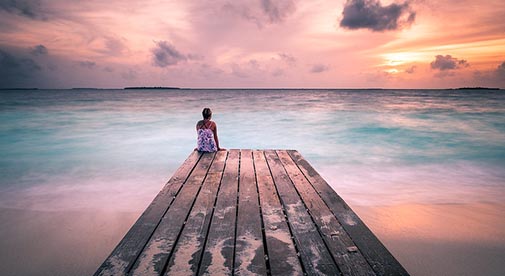Travel photography can be tricky. Attractions at a destination are often a minefield of obstacles. You get photobombed constantly, people bump into you, and it can feel like hours waiting for that split second when thousands of tourists part like the Red Sea so you can finally take a photo.
This is normal and part of travel photography. The good news is there are some handy tricks you can use to help reduce these obstacles, and your stress, to get a saleable shot.
The last thing you want is to produce yet another photo that looks like thousands of others. The one taken standing in front of an attraction loaded with tourists’ heads filling the bottom of your image.
So, here are five handy tips and tricks I’ve used to help get a great shot while reducing my frustration and upping the fun factor. After all, travel photography is great fun when you aren’t stressed about getting the photo.
1. Use your surroundings
Block tourists out by taking a photo from behind something. A park bench or large strand of beautiful deep magenta bougainvillea flowers for example.

By stepping back onto the street, shooting from a little lower while tilting the camera up I used this bougainvillea to block the constant flow of tourists entering this famous church.
Alternatively, you can use a natural frame like a window for a different style of photo. This makes people feel like they are looking at an authentic street scene so they expect to see tourists.
2. Use the crowds
Say you want to photograph a cathedral. But it’s in the main square with tourists, locals, street vendors and a million pigeons. Use them.
Use its life. It is the main square. It will always be very busy, so capture it. That is the destination. Get down low and wait for the pigeons to take flight, it will block most of the other people and street vendors out, while showing the church in the background making a dynamic shot. Plus, kids chasing pigeons adds a delightful human element and there are always kids chasing pigeons, so you won’t have to wait long.
3. Get high
Change your angle by changing your elevation. Get on a balcony, rooftop, or even climb a tree. This different angle can make for a more interesting image. Like this photo at a Guatemalan coffee plantation. I stood on a wall, which cut out all the tourists in front. Now it’s a clean and saleable shot of turning coffee beans as part of the sun drying process.

I’ve crawled over things, climbed trees and statues, and stood on more park benches and walls than I care to admit. It doesn’t hurt anyone, so be brave and go for it. People may look at you strangely but it will help your photography progress in leaps and bounds.
4. Get up front
Tourists are generally too busy looking at the attraction and won’t even be aware they have wandered into your shot. They’re usually not actively trying to get in the way. If you can’t get up high or use the terrain to hide them, try simply going in front of them. Get close to the attraction and you’ll have a clear view. Respectfully of course—don’t barge your way to the front. Wait your turn or ask politely.
Using this tactic will often put you close to the attraction. A wide angle lens will help you get an impressive shot from relatively close-up.
5. Go at the right time
The golden hour and blue hour at sunrise and sunset are magic. Plan your visit to major attractions and use them. It’s less crowded at sunrise because people haven’t arrived yet, or at sunset because tourist buses have left and people are going to dinner not sightseeing.
Plus, these times of day create a softer diffused natural lighting like in this early morning image of the hugely popular entrance to Bayon Temple in Siem Reap Province, Cambodia.

Taken early in the morning, it shows serenity instead of thousands of tourists!
Waiting for sunset also has an added bonus. A lot of attractions are lit around dusk making a more dynamic shot. I’ve even sat in nearby restaurants and enjoyed a glass of wine waiting for the gorgeous deep cobalt of blue hour to arrive and make my shots really pop before night truly descends.
By doing these things, changing your angle, getting up high and using the golden and blue hours, your images will become a lot more saleable and take your photography to the next level.
[Editor’s Note: Learn more about how you can fund your travels and make an extra income with photography, travel writing, blogging, and more in our free online newsletter The Right Way to Travel. Sign up here today and we’ll send you a new report, Three Fun Ways To Get Paid To Travel: A Quick-Start Guide, completely FREE.]

